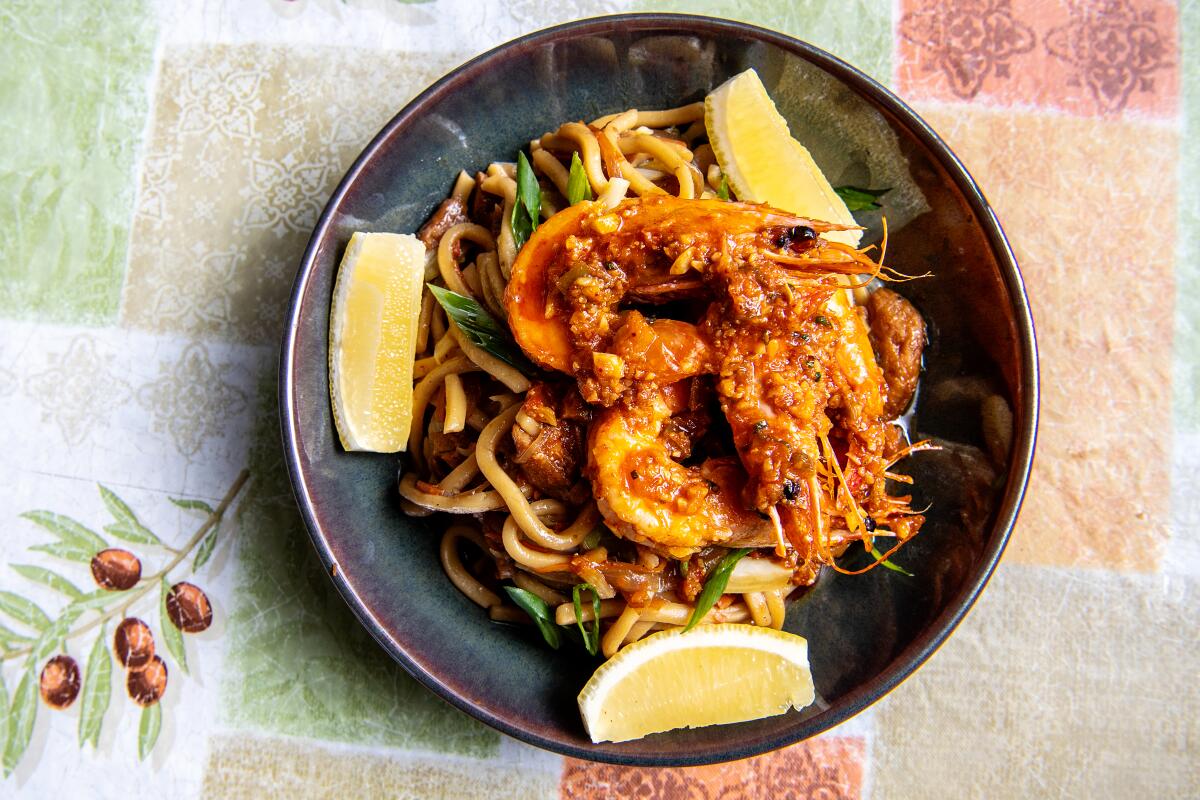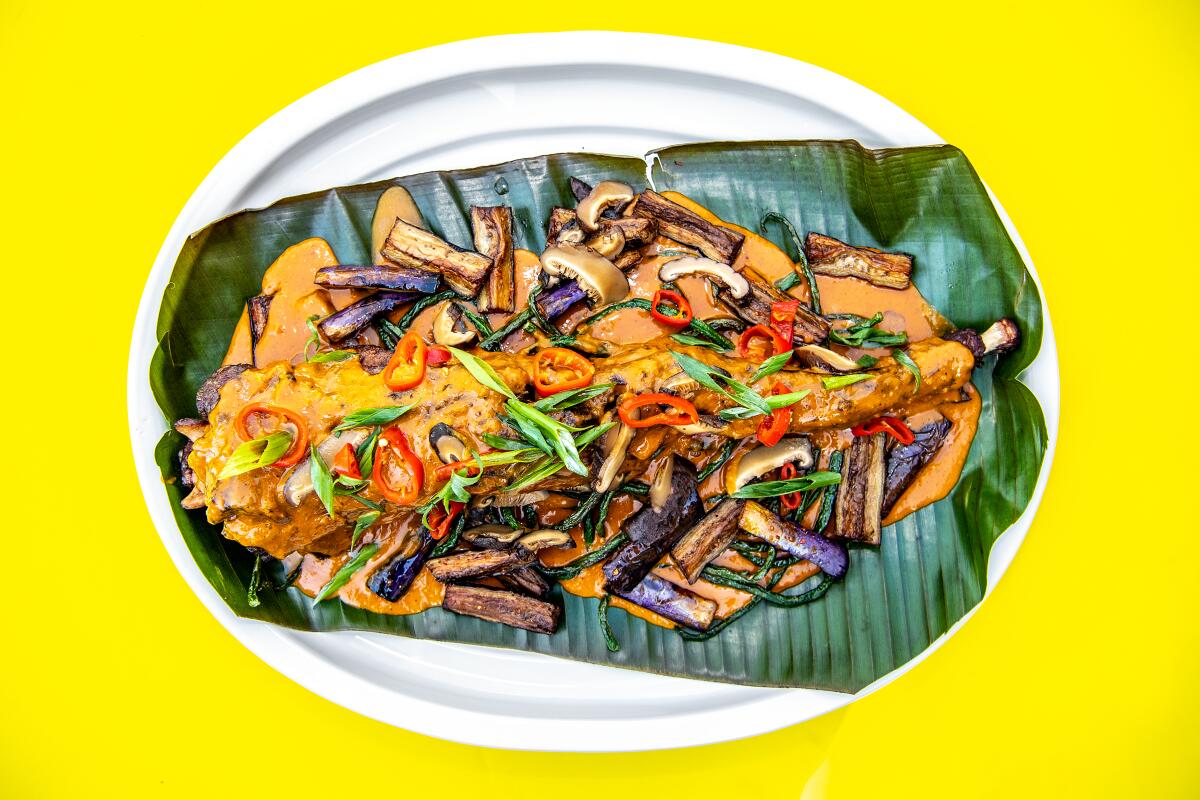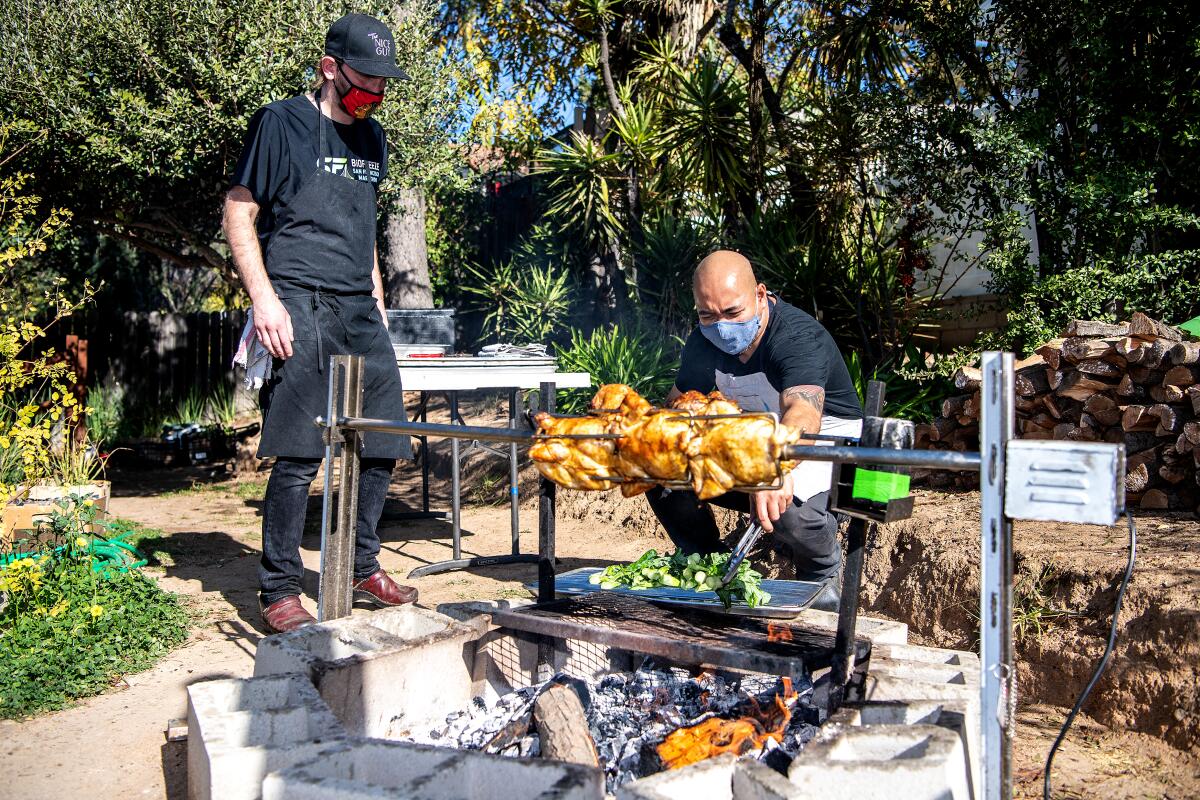Kuya Lord’s Filipino feast is food of power, finesse and delight

- Share via
Like most of the dishes Lord Maynard Llera prepares for Kuya Lord, the pop-up he operates out of his home in La Cañada Flintridge, he packs his version of kare-kare into an aluminum tray lined with banana leaf. The stew, a staple of Filipino cuisine, in this case more resembles a sauce; it clings to a row of smoked Wagyu oxtails, the whole presentation shaped loosely into an oval.
Once you remove the lid from the tray, the aroma is too heady to resist swiping a finger through the gravy. The tastes are rich and wild. They don’t stay still.
Restaurant variants of kare-kare tend to accentuate the nutty sweetness of ground peanuts, an essential ingredient in the stew. Llera atomizes peanuts into buttery smoothness for his kare-kare, but as a flavoring he uses them as a backdrop. He makes his own bagoong (fermented seafood paste) from shrimp, giving it an extra hit of garlic to temper the funk. Bagoong is traditionally served as a condiment with kare-kare; here it also becomes a critical element in the sauce.
Unbridled umami meets woodsy smoke on the taste buds. The intensity can bring to mind cured sausage, though oceanic depths rise up in waves too.
Llera scatters vegetables — slivers of smoked shiitakes, snipped pickled Fresno chiles, hunks of eggplant with purple skins popping against the earth tones — over his kare-kare the way fashionable bakers arrange cut fruits and tiny stemmed flowers on frosted layer cakes. Fried long beans lie alongside, coiled like a lasso.

This is a feast, enough to feed three or four, and the most ornate dish that rotates regularly through the Kuya Lord menu — though there is also frequently a Filipino-inspired version of porchetta made with pork belly, its rolled center filled with lemongrass stalks, fennel fronds and lots of red onion. Carving off a slice reveals loops of taut meat, lush fat and crackling skin as distinct as the rings of Saturn.
The majority of what he cooks — combinations of roasted chicken, fried pork belly stacked in neat rectangles, jumbles of prawns in crab sauce, garlic rice and noodles — comes arrayed on trays that channel the spirit of kamayan, the communal meals spread on banana leaves and eaten by hand. This is food of power and finesse and profound delight.
Llera views this initial pop-up phase of Kuya Lord as pandemic survival but also as research and development for the restaurants he plans to open when the crisis abates. He’s been inching toward running his own business for nearly 20 years.

Lucena City, a port town in the Philippines’ agriculturally abundant Quezon province, about four hours south of Manila, was home until Llera moved to the United States in 2004. He went to culinary school in New York but gravitated to Los Angeles. “I was determined to be independent from my close family, but I had a lot of friends and relatives who could support me in Southern California,” he said in a recent phone interview.
He was the opening sous chef at Bestia, working with Ori Menashe and Genevieve Gergis for almost four years. In 2017, wanting to learn the mechanics behind operating a multi-unit restaurant company, he became culinary director for the h.wood group. Llera left it in 2019, the year he turned 40, to host pop-up dinners while gearing up to open his own place. He tends to go by his middle name, Maynard, but friends such as Ken Concepcion and Michelle Mungcal of Now Serving L.A. call him “Kuya Lord”; “kuya” is a Tagalog term of respect meaning older brother. The moniker stuck for his venture.
His dishes merge his childhood memories with his professional experience. He makes most of them in a kitchen he fashioned in his garage, or in his backyard on an outdoor rotisserie. “I don’t follow traditional Filipino recipes exactly,” he said. “For my menu, I want to create things that keep my own interest, that I’m going to eat myself.”
That doesn’t mean Llera rejects the regional dishes he grew up with. Pancit chami, a specialty of Quezon province, highlights miki noodles — thick, rounded strands made with eggs that directly reflect Chinese culinary influences on the Philippines. They show up threaded with vegetables in a cardboard boat on one of the combo trays or tossed with cubes of lechon kawali (fried pork belly). In whatever form the pancit appears, it still carries the sizzled scent of a blazing wok.
Ginisang sugpo sa aligue, prawns in garlicky crab paste with calamansi juice and fish sauce, delivers a high-potency dose of salt, sour and fermented umami. The combination goes for extremes but doesn’t veers out of balance: The sweetness of the prawns is never overwhelmed. Your brain keeps decoding the complexities as you drag noodles or rice through the remaining pool of sauce.

Llera is just as masterful employing subtlety. Chickens absorb the fragrance of almond wood as they spin on the rotisserie; he’s discovered during the pop-up that he prefers the understated campfire scent almond imparts over, say, the heavier perfume from oak. The pureed sauce on the side? A blend of chicken livers, coconut vinegar, garlic and black pepper that’s light on ferric bite and thick with nuance.
A frequent special to watch for: inihaw na panga, grilled yellowtail collar served with gai lan. First excavate an unadorned forkful of meat from the collar’s nooks to appreciate the precision cooking. Then add drops of garlic-chili oil and toyomansi (a dip of calamansi and soy), consider the dimensions to other worlds they open, and finally mix in homemade achara, a tensely sour-sweet pickle made from green papaya. Revelations.
The last decade has witnessed a prevailing, overdue recognition of Filipino food locally and nationally. Los Angeles claims its share of triumphs. Among them are the inventive modernism of Chad and Chase Valencia’s Lasa in Chinatown (who’ve recently announced they’re revisioning the place as Lasita Filipino Rotisserie & Natural Wine), the profound joys of the braised and fried pork shank called patita (still incredible in takeout form) from Spoon & Pork in Silver Lake and the warming rice bowls from downtown’s Petite Peso.
There have been disheartening fluctuations as well: the closing of genre-pushing Irenia in Santa Ana in 2019 and the hard loss last year of Charles Olalia’s beachy, often-brilliant Ma’am Sir in Silver Lake.
Finding his audience on Instagram, making his food available for pick-up most every weekend, Llera joins the many professionally displaced chefs who have created opportunities where there seemingly were none. We can’t know how restaurant life will unfold once it’s safe for all of us to eat together again in dining rooms. But even eating smoked oxtails and pancit from an aluminum tray at home, it’s obvious that in Llera we have a thrilling new expressionist of Filipino flavors — a talent whose time is now.
Kuya Lord on Instagram: @kuyalord_la
More to Read
Eat your way across L.A.
Get our weekly Tasting Notes newsletter for reviews, news and more.
You may occasionally receive promotional content from the Los Angeles Times.








